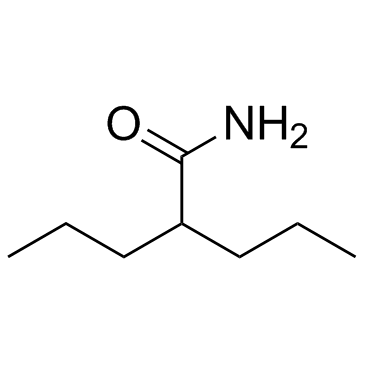Valpromide

Valpromide structure
|
Common Name | Valpromide | ||
|---|---|---|---|---|
| CAS Number | 2430-27-5 | Molecular Weight | 143.22700 | |
| Density | 0.885g/cm3 | Boiling Point | 274.6ºC at 760mmHg | |
| Molecular Formula | C8H17NO | Melting Point | 123-125°C | |
| MSDS | Chinese USA | Flash Point | 119.9ºC | |
| Symbol |

GHS07 |
Signal Word | Warning | |
|
The synergistic effects of DNA-damaging drugs cisplatin and etoposide with a histone deacetylase inhibitor valproate in high-risk neuroblastoma cells.
Int. J. Oncol. 47 , 343-52, (2015) High-risk neuroblastoma remains one of the most important therapeutic challenges for pediatric oncologists. New agents or regimens are urgently needed to improve the treatment outcome of this fatal tumor. We examined the effect of histone deacetylase (HDAC) i... |
|
|
Amidic modification of valproic acid reduces skeletal teratogenicity in mice.
Birth Defects Res. B Dev. Reprod. Toxicol. 71(1) , 47-53, (2004) The antiepileptic drug valproic acid (VPA) is well known to cause neural tube and skeletal defects in both humans and animals. The amidic VPA analogues valpromide (VPD) and valnoctamide (VCD) have much lower teratogenicity than VPA inducing exencephaly in mic... |
|
|
Polycomb homologs are involved in teratogenicity of valproic acid in mice.
Birth Defects Res. A Clin. Mol. Teratol. 70(11) , 870-9, (2004) Valproic acid (VPA) is widely used to treat epilepsy and bipolar disorder and is also a potent teratogen, but its teratogenic mechanisms are unknown. We have attempted to describe a fundamental role of the Polycomb group (Pc-G) in VPA-induced transformations ... |
|
|
Mood-stabilizers: the archeology of the concept.
Bipolar Disord. 5(6) , 446-52, (2003) To review the history of 'mood-stabilizing' treatments.We have reviewed primary source data on the origin of the use of current mood-stabilizers.This historical record on the origins of the mood-stabilizers points to a more ambiguous picture as regards pharma... |
|
|
Mood stabilizer augmentation in apparently "unipolar" MDD: predictors of response in the naturalistic French national EPIDEP study.
J. Affect. Disord. 84(2-3) , 243-9, (2005) Mood stabilizers (MS), especially Lithium, are used in augmentation strategies for resistant depression. However the broader bipolar spectrum (depressions with brief [i.e. 2 days] hypomania, cyclothymic and hyperthymic temperaments) has rarely been explored i... |
|
|
Characterization of the anticonvulsant profile of valpromide derivatives.
Bioorg. Med. Chem. 12(14) , 3857-69, (2004) The antiepileptic activity of nine derivatives of valpromide is discussed. They comply with a pharmacophore model that establishes the essential structural and electronic features responsible for the protection against the MES test. The model results from the... |
|
|
Histone deacetylases are required for amphibian tail and limb regeneration but not development.
Mech. Dev. 129(9-12) , 208-18, (2012) Amphibians such as Xenopus laevis and Ambystoma mexicanum are capable of whole structure regeneration. However, transcriptional control over these events is not well understood. Here, we investigate the role of histone deacetylase (HDAC) enzymes in regenerati... |
|
|
Sodium valproate potentiates staurosporine-induced apoptosis in neuroblastoma cells via Akt/survivin independently of HDAC inhibition.
J. Cell. Biochem. 114(4) , 854-63, (2013) Sodium valproate (VPA) has been recently identified as a selective class I histone deacetylase (HDAC) inhibitor and explored for its potential as an anti-cancer agent. The anti-cancer properties of VPA are generally attributed to its HDAC inhibitory activity ... |
|
|
Management of epilepsy in adults. Diagnosis guidelines.
Postgrad. Med. 118(6) , 22-6, (2005) In this first of two articles on new epilepsy guidelines for primary care physicians, the authors present detailed algorithms for the diagnosis and classification of seizure disorders in adults. They discuss the differentiation between generalized and partial... |
|
|
Effect of melatonin and melatonylvalpromide on beta-amyloid and neurofilaments in N2a cells.
Neurochem. Res. 33(6) , 1138-44, (2008) In the present study, we have studied the effect of melatonin (Mt) and melatonin derivative, i.e., melatonylvalpromide (Mtv), on cell viability, beta-amyloid (Abeta) production, cell morphology, and expression and phosphorylation of neurofilament proteins in ... |